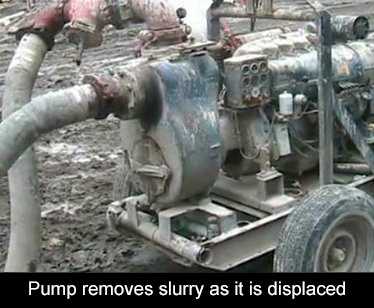Here's a rack which holds the sections of tremie pipe. The laborer has just joined two sections together, and he's inserting a gasket which will connect two pipes. Now the tremie pipe is being lowered into the panel that is going to be concreted.
You see these two trapdoors are sized to grab onto the pipe and hold it in place. Now all they need to do is add the hopper, which they've done in this shot. They're now lowering this to the fullest extent. It's actually going to go down and rest on the bottom of the excavation. And that's the intent. That's where you begin concrete.
Now you can see the level of slurry is rising. The concrete is entering the excavation, and it is displacing the slurry. That slurry has to be removed and that's done by pumping it out. This is an end stop, which is forming the end of the concrete panel that's being concreted.
 This is the pump that's removing the displaced slurry. If the timing is right, you can place it right in a panel that's being excavated. The foreman has checked the level of concrete and determined that it's time to remove a section or two of the tremie pipe.
This is the pump that's removing the displaced slurry. If the timing is right, you can place it right in a panel that's being excavated. The foreman has checked the level of concrete and determined that it's time to remove a section or two of the tremie pipe.
They have disconnected two lengths of pipe and they're sending it back to that rack in the background, where it's going to be stored. Now the hopper is going to be reconnected and they aree ready to concrete again.
This hopper was located in the center of the panel. The panel is 16 feet long and they are going to relocate this hopper and put it on one end of the panel. There is already a tremie pipe installed at the opposite end of the panel and they pick up this assembly and reset it at the end.
Please note, the laborer in the background has found two empty bags. These bags probably are what the Bentonite is delivered in. He's taking one bag and he stuffed it in that tremie pipe. He's got the other one in his hand. I'd like you to think a little about what he could possibly be doing with these bags.
They established this tremie pipe at one end of the panel, and they're ready to continue with the concreting operation.